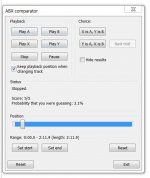Sorry, Scott, 🙂, I'm going with the "dirty" version of the vinyl - I prefer to hear absolutely everything that was there in the first place. I have some CDs of disk originated material, where some tracks have been "tampered with", others left au natural, and the latter are definitely are "nicer" to listen to ...
Always on the lookout for good "killer" CDs, 😀 - ones that put severe stress on the potential weak points in typical systems, which means they very easily become diabolical to listen to, even though they are technically correct in themselves, 🙂. A recent addition is Jimmy Barnes, Soul Deeper - a relatively recent tribute to the Motown sound ... this makes something like recent AC/DC recordings sound like baby food in terms of the production.
Start with Motown sound itself, stuffed full with big, brassy sound, with every inch rich in excess. Add in EQ that mimics beautifully the intense midrange bite of that era's recordings. Then, a very solid dollop of modern, year 2000 studio manipulation that pushes intensity of sound, volume compression such that barely touching the gain means the sound ruthlessly punches into the listening place. Oz mastering gives it a further driving quality, that classic no nonsense, in your face, live pub sound. And, to round it off, the screaming, no holds barred vocals of Jimmy himself.
Wind this up on the normal 'audiophile' setup, and you would have people running, screaming in all directions; smashing holes through window glass to escape from the aural onslaught ... 😉
Just thought it was worth a mention ... 😛
Start with Motown sound itself, stuffed full with big, brassy sound, with every inch rich in excess. Add in EQ that mimics beautifully the intense midrange bite of that era's recordings. Then, a very solid dollop of modern, year 2000 studio manipulation that pushes intensity of sound, volume compression such that barely touching the gain means the sound ruthlessly punches into the listening place. Oz mastering gives it a further driving quality, that classic no nonsense, in your face, live pub sound. And, to round it off, the screaming, no holds barred vocals of Jimmy himself.
Wind this up on the normal 'audiophile' setup, and you would have people running, screaming in all directions; smashing holes through window glass to escape from the aural onslaught ... 😉
Just thought it was worth a mention ... 😛
Last edited:
Ultimate listening test huh ..🙂 BTW motown is horrible crap , worst recordings by some of the best , Barry Gordy should be arrested ...
🙄
🙄
Yep, it works that way ... if you can make the 'worst' recording in your collection "work" as a valid, enjoyable musical event, and not a torture test - without dumbing it down - then it opens the horizons so much further. You can put on any old bit of "rubbish" - some completely unknown artist, style of music, a crappy bootleg - and get a buzz from listening to it first time through, ones "gets" the musical point ...
Classic old Motown tracks are an excellent system test, because they were done the way they were - can one's system retrieve all the musical detail, without adding another layer of muck to the sound ...?
Classic old Motown tracks are an excellent system test, because they were done the way they were - can one's system retrieve all the musical detail, without adding another layer of muck to the sound ...?
Thanks for your input.
foobar ABX mutes output for >100ms during track switch. Residual charge of coupling capacitor discharging is evident in the gaps.
I recorded foobar ABX output at both analog and digital signal. For digital recording, ABX gaps are zero value samples.
Here are views of gaps with analog recording:
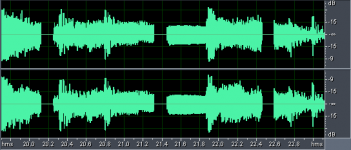
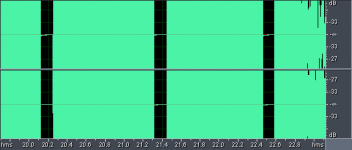
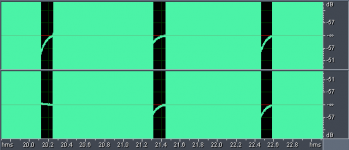
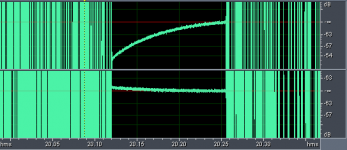
foobar ABX produces popping sound like break and make of relay in series with capacitor.
Cool Edit switches sample streams, discontinuity is limited to difference of last sample of old stream and first sample of new stream. Coupling capacitors is playback system have no relaxation period:
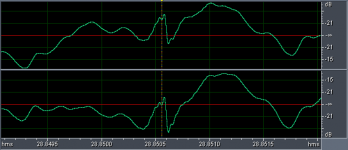
How does this effect ability to discriminate high pass behavior of two recorded streams?
Capacitive settling seen in foobar ABX gaps is that of actual playback system; yet it makes it possible for some people to differentiate. Why is this?
More food for thought:
In Texas Instruments AN-1490 they state in section 3.6.1:
In listening tests at TI's sound room evaluating different circuit components used in the LM4702 demo
amplifier, there was one part whose negative effect on audible signal quality was undeniable. A DC
blocking capacitor on the input of the LM4702 degraded sound quality. In multiple listening tests, with
different participants and at various locations around the country, the negative effects of even the best film
and foil polystyrene DC blocking input capacitors in the audio signal path was confirmed. It is therefore
recommended that DC blocking capacitors not be used in the signal path for mid to high-end audio
equipment. Where DC offset from another signal source may be a problem then the use of a DC servo
circuit that keeps DC offset from appearing at the output of the amplifier is recommended.
It would sure be nice to have details from the above studies.
Some thoughts; If low frequency cutoff of playback system is lower than that contained in playback signal, then all details of signal may be heard. If playback system bandwidth is lower, than some discriminating details are lost. Single biggest point of loss is speakers. With ear buds sealed in ear canal, low frequency response becomes mostly that of electronics.
Thank you for your input, very interesting.
On the other hand, I never use switching between tracks to find the sound difference. I always play certain segment of music through "X" button, then through "Y" button, sometimes I repeat it and then try to decide if X was A or B. In case of this test (file x D/A - A/D) I always listened first 20s approx. and then made a decision. So, the result was not affected by foobar switching. Instant switching is misleading to me, I get no result then.
On the other hand, I never use switching between tracks to find the sound difference. I always play certain segment of music through "X" button, then through "Y" button, sometimes I repeat it and then try to decide if X was A or B. In case of this test (file x D/A - A/D) I always listened first 20s approx. and then made a decision. So, the result was not affected by foobar switching. Instant switching is misleading to me, I get no result then.
Attachments
Last edited:
This is the 'sound' that was removed by cleaning the vinyl file
https://www.dropbox.com/s/2mas1ukpg2f3io1/vinyl_cleaned-vinyl.wav
That is remarkable in itself, plus there is no audio that I could detect on a quick listen in that file, and yet the cleaned version looses much "quality or musicality".
Oh no, to me the original file is more relaxed, more pleasant, more full, less harsh and has better decay into silence.
Yes, please tell me which is which.
I still would like to know which file, apple or pear, you assume to be an original file (the second one is a D/A --> A/D product). By now, I have received only one PM with correct answer from a member who has not sent an ABX result.
Apple vs Pear.
I'm feeling more relaxed and had another listen. I found "something" sonically I could pick up on... I'll pm you 😀
(I did as you mentioned and just listened to each from the start rather than picking segments)
Do you want me to say which I prefer ?
I'm feeling more relaxed and had another listen. I found "something" sonically I could pick up on... I'll pm you 😀
(I did as you mentioned and just listened to each from the start rather than picking segments)
Do you want me to say which I prefer ?
Attachments
Do you want me to say which I prefer ?
It would be nice, if you don't mind.
BTW, nice result, congratulations!
Thanks 🙂
I prefer Pear. I listened on h/phones at normal but not loud level and with flat equaliser response.
I prefer Pear. I listened on h/phones at normal but not loud level and with flat equaliser response.
Thanks 🙂
I prefer Pear.
And you are doing right!! 😀
Very good job, Pear is the original.
Mooly,
in above picture you have "Keep playback when changing track" checked. You are listening from beginning each time and listening to same stop point? Or do you change tracks while listening?
in above picture you have "Keep playback when changing track" checked. You are listening from beginning each time and listening to same stop point? Or do you change tracks while listening?
Thanks 🙂
I had my hair cut yesterday so ears are now more exposed, less attenuating material in the way 😀
I had my hair cut yesterday so ears are now more exposed, less attenuating material in the way 😀
Mooly,
in above picture you have "Keep playback when changing track" checked. You are listening from beginning each time and listening to same stop point? Or do you change tracks while listening?
I listened from the beginning. I could differentiate the two from the first 10 to 15 seconds worth.
Barley, IMO the clicks and transients during foobar buttons push should be avoided as an evaluation method. I have always considered it as some interference or disturbance and never tried to evaluate the sound based on these disturbing transient noises. I am really surprised that someone tries to catch the sound difference based on these disturbing transients. On the other hand, purely technical approach, not based on sound differences but on a kind of circuit/system misbehavior - yes, some may get concentrated on such non-musical noises.
I could never do an ABX test by swapping mid track. The slight dip/click/mute as one track switches to the other causes me to have a loss of concentration.
This is the first test I have done where I listened from the beginning and it was more effective than I thought. Previously I had tried to pick short segments in a track where I felt there should be some identifiable sonic difference rather than just letting the track "wash over" me from the start. That approach failed miserably on the Apple vs Pear where I just listened in a relaxed state of mind to the music from the start.
This is the first test I have done where I listened from the beginning and it was more effective than I thought. Previously I had tried to pick short segments in a track where I felt there should be some identifiable sonic difference rather than just letting the track "wash over" me from the start. That approach failed miserably on the Apple vs Pear where I just listened in a relaxed state of mind to the music from the start.
Damn Im late to the party. I brought the wav files home and couldn't play it on my "toy for kids" aka Samsung android. It must be that high end wav again. But I'm curious about what I think was direct. On $2 headphone and a pc I could only listen for musicality which I think is sufficient to know which one is direct. But PMA thinks seriously about how hardware can switch results. That's what I want to check/prove.
- Status
- Not open for further replies.
- Home
- General Interest
- Everything Else
- Ultimate listening test - trial no. 3

